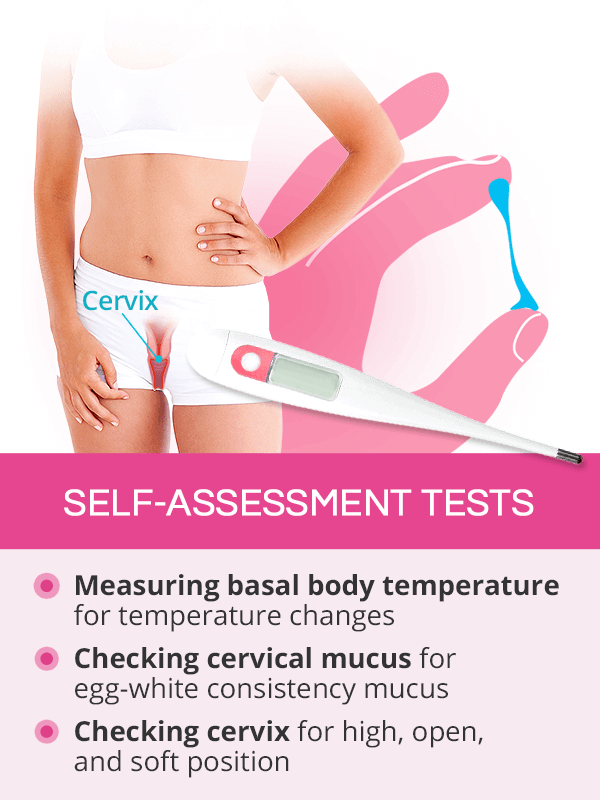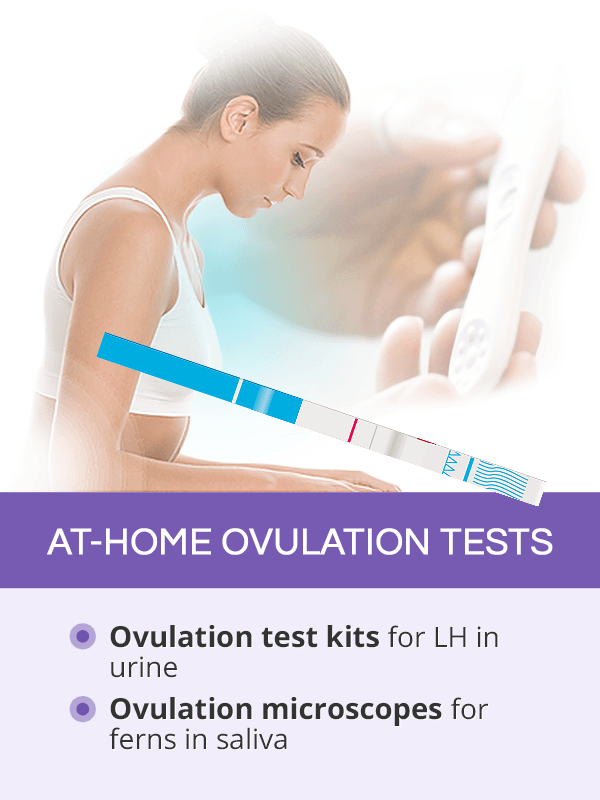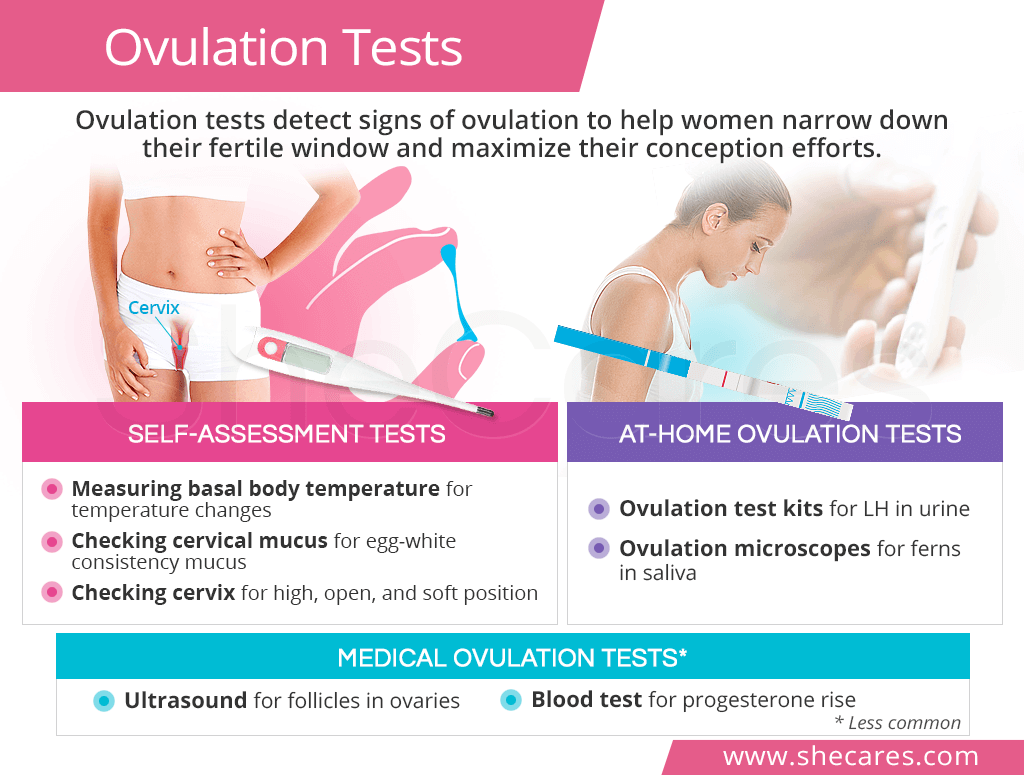Self-Assessment Ovulation Tests

Because ovulation day can occur at slightly different times each month, developing good observation skills through self-assessment tests can help women narrow down their fertile window, thus maximizing their conception efforts.
There are three ways to assess whether ovulation is approaching. They include:
Measuring Basal Body Temperature (BBT)
Measuring basal body temperature is one of the most common ovulation tests. It is easy and straightforward, but it requires taking daily measurements for several months.
BBT is the temperature of the body at rest. Right before ovulation begins, there is a very small decrease in BBT, which is then followed by an increase as soon as ovulation starts. Recording this 0.4 - 1°F (0.2 - 0.5°C) increase over a few months will produce patterns of a woman's ovulatory cycle.
For accurate readings, it is recommended to purchase a special BBT thermometer that can detect small temperature changes. It is best to measure BBT upon waking up before getting out of bed.
Measuring BBT is the only at-home ovulation test that can confirm that ovulation has actually taken place, while others verify that ovulation is approaching. It is worth remembering, however, that other factors, such as ongoing infections, might also affect body temperature.
Checking Cervical Mucus
Many women notice changes in their vaginal mucus throughout the cycle without even realizing it. But for those preparing for pregnancy, checking cervical mucus is a helpful method of tracking down their ovulation.
As ovulation is approaching, the levels of estrogen are rising steadily, which makes the cervical mucus stretchy, clear, and more abundant. This egg-white consistency cervical mucus is a sign that a woman is in her fertile days. It does not, however, confirm that an egg has been released.
It is important to keep in mind that that other factors, such ongoing infections or diseases, might also affect the vaginal discharges.
Checking Cervical Position
Although it is generally a less preferred ovulation test, checking cervical position around ovulation can give cues about a woman's ovulatory phase in a given time.
When a woman is in her fertile days, the cervix moves higher up into the body to facilitate the passage of the sperm into the reproductive tract. It also becomes soft, moist, and open.
These cervix changes during ovulation can be detected by inserting a clean finger into the vagina and locating the cervix. Because of its position, the cervix might be more difficult to locate around ovulation. It is, therefore, necessary to self-examine regularly throughout the cycle in order to notice the shift.
Also, because improperly washed hands can transfer disease-causing microbes directly into the reproductive tract, good hygiene is highly advised.
At-Home Ovulation Tests

At-home ovulation tests can also be performed without relying on a doctor.
These ovulation detectors can confirm that the ovulation signs a woman has been observing through self-assessment, such as fertile mucus and BBT shifts, do correspond to approaching ovulation.
There are two most popular at-home ovulation tests women can purchase online or at a local pharmacy:
Ovulation Test Kits
The purpose of ovulation test kits, also called ovulation predictor kits (OPK), is to detect a rise in the levels of luteinizing hormone (LH), called an LH surge. Some also detect estrogen levels.
A sharp LH increase is preceded by rising estrogen and eventually triggers the release of an egg 24 to 36 hours later. The pattern of increasing luteinizing hormone levels with the peak at 25-40 mlU/mL is a good indication that ovulation is about to take place, but the ovulation test kits cannot confirm if the egg is actually released.
Many ovulation test kits come with a month-supply of testing strips, which are designed to be submerged in urine near ovulation.
Some medical conditions, such as polycystic ovarian syndrome (PCOS) or luteinized unruptured follicle syndrome (LUFS), can cause ovulation problems and produce false LH surges or trigger a surge without releasing the egg.
To make testing and charting more convenient, there are also ovulation monitors that combine ovulation test kits and ovulation trackers into one device.
Ovulation Microscopes
Ovulation microscopes work by detecting the presence of crystalline structures, called ferns, in the saliva that form prior to ovulation.
As a woman nears her ovulation day, an estrogen increase changes the salinity of her saliva. As a result, distinct structures are created that resemble ferns, which can be seen in a sample of dried saliva.
Once the ferning pattern is detected with an ovulation microscope, ovulation is predicted to occur in the next 24 to 72 hours; therefore, it is a good idea to plan intercourse within that time frame.
Measurements have to be taken daily first thing in the morning before drinking, eating, or brushing one's teeth.
Medical Ovulation Tests
Although self-assessment and at-home testing are considered the best ovulation tests, there are other examinations that can be performed at a medical facility to confirm that ovulation is near. They include:
Transvaginal ultrasound can be performed for a view of maturing follicles in the ovary when nearing ovulation. But because of the considerably higher cost of the test and the inconvenience of having to perform it daily at a medical facility, it is not a preferred ovulation test.
Blood test can check progesterone levels, which increase with the onset of ovulation. Results showing progesterone levels higher than 20nmol/L indicate that ovulation has occurred.
Key Takeaways
Women planning to get pregnant are commonly in search for ways to estimate the time of ovulation. One of the best ways to confirm that ovulation is, in fact, approaching is through ovulation tests. The two most commonly used ones consist of self-assessment tests, such as checking basal body temperature, cervical mucus, or cervical position, and at-home ovulation tests, which include ovulation test kits and microscopes. Alternatively, medical tests, such as ultrasounds or blood tests, can also be used to estimate when ovulation takes place, although they are not preferred approach. Overall, ovulation tests are helpful tools in optimizing conception efforts and detecting ovulation problems, especially in women undergoing evaluations for infertility.
Sources
- American Pregnancy Association. (2018). Ovulation Tests. Retrieved August 27, 2018 from http://americanpregnancy.org/getting-pregnant/ovulation-tests/
- Better Health Channel. (2018). Ovulation. Retrieved August 27, 2018 from https://www.betterhealth.vic.gov.au/health/conditionsandtreatments/ovulation
- Human Reproduction. (2013). Home ovulation tests and stress in women trying to conceive: a randomized controlled trial. Retrieved August 27, 2018 from https://www.ncbi.nlm.nih.gov/pmc/articles/PMC3522415/
- FDA. (2018). Ovulation (Urine Test). Retrieved August 27, 2018 from https://www.fda.gov/medicaldevices/productsandmedicalprocedures/invitrodiagnostics/homeusetests/ucm126065.htm
- Medline Plus. (2018). Ovulation home test. Retrieved August 27, 2018 from https://medlineplus.gov/ency/article/007062.htm
- Reproductive Health. (2015). Women's experiences of ovulation testing: a qualitative analysis. Retrieved August 27, 2018 from https://www.ncbi.nlm.nih.gov/pubmed/26689590


